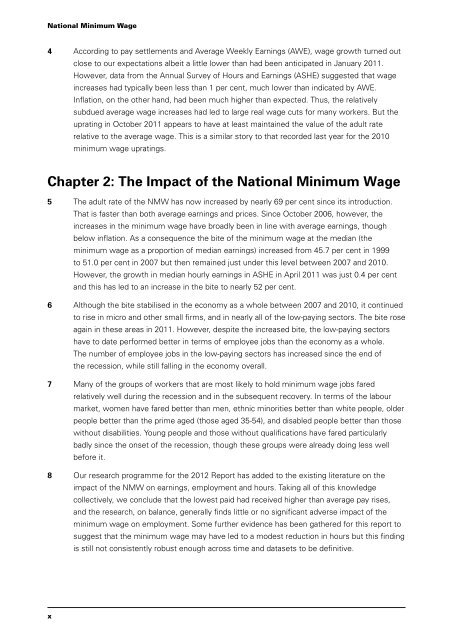National Minimum Wage
National Minimum Wage
National Minimum Wage
Create successful ePaper yourself
Turn your PDF publications into a flip-book with our unique Google optimized e-Paper software.
<strong>National</strong> <strong>Minimum</strong> <strong>Wage</strong><br />
4 According to pay settlements and Average Weekly Earnings (AWE), wage growth turned out<br />
close to our expectations albeit a little lower than had been anticipated in January 2011.<br />
However, data from the Annual Survey of Hours and Earnings (ASHE) suggested that wage<br />
increases had typically been less than 1 per cent, much lower than indicated by AWE.<br />
Inflation, on the other hand, had been much higher than expected. Thus, the relatively<br />
subdued average wage increases had led to large real wage cuts for many workers. But the<br />
uprating in October 2011 appears to have at least maintained the value of the adult rate<br />
relative to the average wage. This is a similar story to that recorded last year for the 2010<br />
minimum wage upratings.<br />
Chapter 2: The Impact of the <strong>National</strong> <strong>Minimum</strong> <strong>Wage</strong><br />
5 The adult rate of the NMW has now increased by nearly 69 per cent since its introduction.<br />
That is faster than both average earnings and prices. Since October 2006, however, the<br />
increases in the minimum wage have broadly been in line with average earnings, though<br />
below inflation. As a consequence the bite of the minimum wage at the median (the<br />
minimum wage as a proportion of median earnings) increased from 45.7 per cent in 1999<br />
to 51.0 per cent in 2007 but then remained just under this level between 2007 and 2010.<br />
However, the growth in median hourly earnings in ASHE in April 2011 was just 0.4 per cent<br />
and this has led to an increase in the bite to nearly 52 per cent.<br />
6 Although the bite stabilised in the economy as a whole between 2007 and 2010, it continued<br />
to rise in micro and other small firms, and in nearly all of the low-paying sectors. The bite rose<br />
again in these areas in 2011. However, despite the increased bite, the low-paying sectors<br />
have to date performed better in terms of employee jobs than the economy as a whole.<br />
The number of employee jobs in the low-paying sectors has increased since the end of<br />
the recession, while still falling in the economy overall.<br />
7 Many of the groups of workers that are most likely to hold minimum wage jobs fared<br />
relatively well during the recession and in the subsequent recovery. In terms of the labour<br />
market, women have fared better than men, ethnic minorities better than white people, older<br />
people better than the prime aged (those aged 35-54), and disabled people better than those<br />
without disabilities. Young people and those without qualifications have fared particularly<br />
badly since the onset of the recession, though these groups were already doing less well<br />
before it.<br />
8 Our research programme for the 2012 Report has added to the existing literature on the<br />
impact of the NMW on earnings, employment and hours. Taking all of this knowledge<br />
collectively, we conclude that the lowest paid had received higher than average pay rises,<br />
and the research, on balance, generally finds little or no significant adverse impact of the<br />
minimum wage on employment. Some further evidence has been gathered for this report to<br />
suggest that the minimum wage may have led to a modest reduction in hours but this finding<br />
is still not consistently robust enough across time and datasets to be definitive.<br />
x


